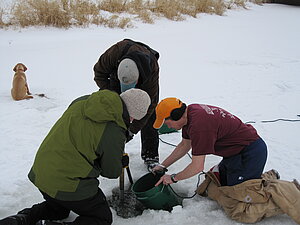
Our objective is to determine the survival and persistence of Cryptosporidium in river sediment.
The survival and persistence of Cryptosporidium in an aquatic environment is critical to its success as a waterborne pathogen. Cryptosporidium has been shown to survive in water for more than 6 months, particularly at low temperatures. At sites that are seasonally impacted by high levels of contamination, such as during pasture grazing of cattle, oocysts may survive and persist in the river after the contamination source has been removed. Although river flow should disperse and dilute contamination, oocysts could be deposited in sediment, where they may become locally concentrated and established as an aquatic reservoir. Sedimented oocysts may subsequently become resuspended as a result of heavy rain, spring flooding, or other events that would cause the river bed to be disturbed. This resuspension of oocysts may contribute to detectable spikes in Cryptosporidium levels and these spikes may be erroneously interpreted as pollution runoff. Understanding the extent to which Cryptosporidium survives and persists in sediment is therefore critical to our overall understanding of the source, fate, and transport of Cryptosporidium in surface water. The objective of this section is to determine the survival and persistence of Cryptosporidium in river sediment. This objective will test our working hypothesis that Cryptosporidium can survive and persist in river sediment and that sediment serves as an environmental reservoir for Cryptosporidium during winter freeze events.
We have just started sampling river sediment below the ice as you can see from the image above. Please check back later for updates.